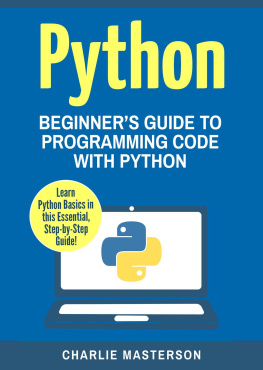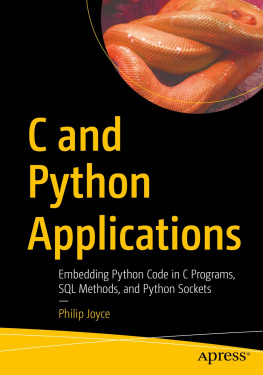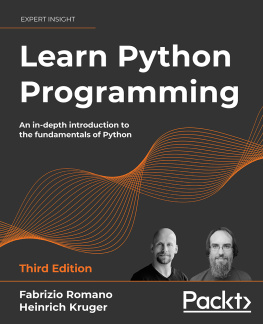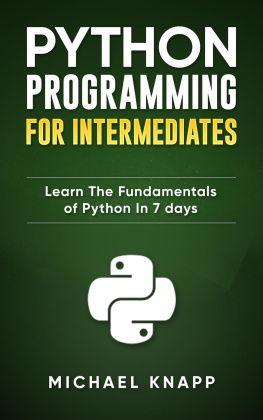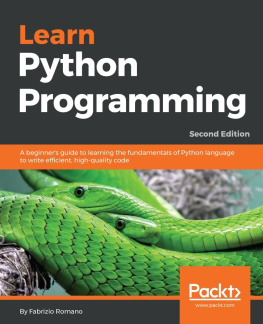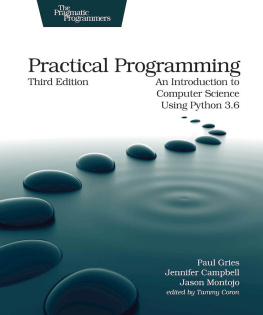Practical Programming, 2nd Edition
An Introduction to Computer Science Using Python 3
by Paul Gries, Jennifer Campbell, Jason Montojo
Version: P2.0 (August 2014)
Copyright 2013 The Pragmatic Programmers, LLC. This book is licensed tothe individual who purchased it. We don't copy-protect itbecause that would limit your ability to use it for yourown purposes. Please don't break this trustyou can use this across all of your devices but please do not share this copywith other members of your team, with friends, or via file sharing services. Thanks.
Dave & Andy.
Many of the designations used by manufacturers and sellers to distinguish their products are claimed as trademarks. Where those designations appear in this book, and The Pragmatic Programmers, LLC was aware of a trademark claim, the designations have been printed in initial capital letters or in all capitals. The Pragmatic Starter Kit, The Pragmatic Programmer, Pragmatic Programming, Pragmatic Bookshelf and the linking g device are trademarks of The Pragmatic Programmers, LLC.
Every precaution was taken in the preparation of this book. However, the publisher assumes no responsibility for errors or omissions, or for damages that may result from the use of information (including program listings) contained herein.
Our Pragmatic courses, workshops, and other products can help you and your team create better software and have more fun. For more information, as well as the latest Pragmatic titles, please visit us at http://pragprog.com.
The team that produced this book includes:
Lynn Beighley (editor)
Potomac Indexing, LLC (indexer)
Molly McBeath (copyeditor)
David J Kelly (typesetter)
Janet Furlow (producer)
Ellie Callahan (support)
For international rights, please contact .
For the Best Reading Experience...
We strongly recommend that you read this book with the publisher defaults setting enabled for your reading device or application. Certain formats and characters may not display correctly without this setting. Please refer to the instructions for your reader on how to enable the publisher defaults setting.
Table of Contents
Copyright 2014, The Pragmatic Bookshelf.
What Readers Are Saying About Practical Programming, Second Edition
I wish I could go back in time and give this book to my 10-year-old self when I first learned programming! Its so much more engaging, practical, and accessible than the dry introductory programming books that I tried (and often failed) to comprehend as a kid. I love the authors hands-on approach of mixing explanations with code snippets that students can type into the Python prompt.
| Philip Guo |
| Creator of Online Python Tutor (http://www.pythontutor.com), Assistant Professor, Department of Computer Science, University of Rochester |
Practical Programming delivers just what it promises: a clear, readable, usable introduction to programming for beginners. This isnt just a guide to hacking together programs. The book provides foundations to lifelong programming skills: a crisp, consistent, and visual model of memory and execution and a design recipe that will help readers produce quality software.
| Steven Wolfman |
| Senior Instructor, Department of Computer Science, University of British Columbia |
The second edition of this excellent text reflects the authors many years of experience teaching Python to beginning students. Topics are presented so that each leads naturally to the next, and common novice errors and misconceptions are explicitly addressed. The exercises at the end of each chapter invite interested students to explore computer science and programming language topics.
| Kathleen Freeman |
| Director of Undergraduate Studies, Department of Computer and Information Science, University of Oregon |
Acknowledgments
This book would be confusing and riddled with errors if it werent for a bunch of awesome people who patiently and carefully read our drafts.
We had a great team of people provide technical reviews: (in no particular order) Steve Wolfman, Adam Foster, Owen Nelson, Arturo Martnez Peguero, C. Keith Ray, Michael Szamosi, David Gries, Peter Beens, Edward Branley, Paul Holbrook, Kristie Jolliffe, Mike Riley, Sean Stickle, Tim Ottinger, Bill Dudney, Dan Zingaro, and Justin Stanley. We also appreciate all the people who reported errata as we went through the beta phases: your feedback was invaluable.
Greg Wilson started us on this journey when he proposed that we write a textbook, and he was our guide and mentor as we worked together to create the first edition of this book.
Last and foremost is our awesome editor, Lynn Beighley, who never once scolded us, even though we thoroughly deserved it many times. Lynn, we cant imagine having anyone better giving us feedback and guidance. Thank you so much.
Copyright 2014, The Pragmatic Bookshelf.
Preface
This book uses the Python programming language to teach introductory computer science topics and a handful of useful applications. Youll certainly learn a fair amount of Python as you work through this book, but along the way youll also learn about issues that every programmer needs to know: ways to approach a problem and break it down into parts, how and why to document your code, how to test your code to help ensure your program does what you want it to, and more.
We chose Python for several reasons:
It is free and well documented. In fact, Python is one of the largest and best-organized open source projects going.
It runs everywhere. The reference implementation, written in C, is used on everything from cell phones to supercomputers, and its supported by professional-quality installers for Windows, Mac OS X, and Linux.
It has a clean syntax. Yes, every language makes this claim, but during the several years that we have been using it at the University of Toronto, we have found that students make noticeably fewer punctuation mistakes with Python than with C-like languages.
It is relevant. Thousands of companies use it every day: it is one of the languages used at Google, Industrial Light & Magic uses it extensively, and large portions of the game EVE Online are written in Python. It is also widely used by academic research groups.
It is well supported by tools. Legacy editors like vi and Emacs all have Python editing modes, and several professional-quality IDEs are available. (We use IDLE, the free development environment that comes with a standard Python installation.)
Our Approach
We use an objects first, classes second approach: students are shown how to use objects from the standard library early on but do not create their own classes until after they have learned about flow control and basic data structures. This allows students to get familiar with what a type is (in Python, all types, including integers and floating-point numbers, are classes) before they have to write their own types.
We have organized the book into two parts. The first covers fundamental programming ideas: elementary data types (numbers, strings, lists, sets, and dictionaries), modules, control flow, functions, testing, debugging, and algorithms. Depending on the audience, this material can be covered in a couple of months.


